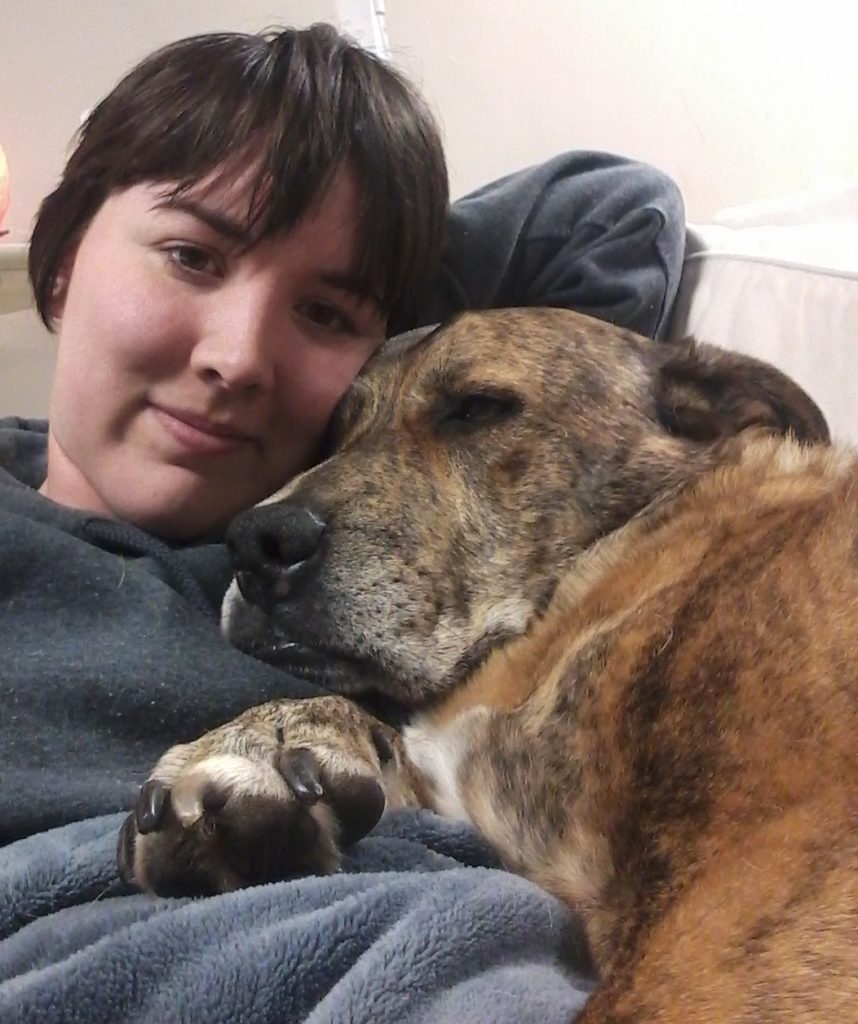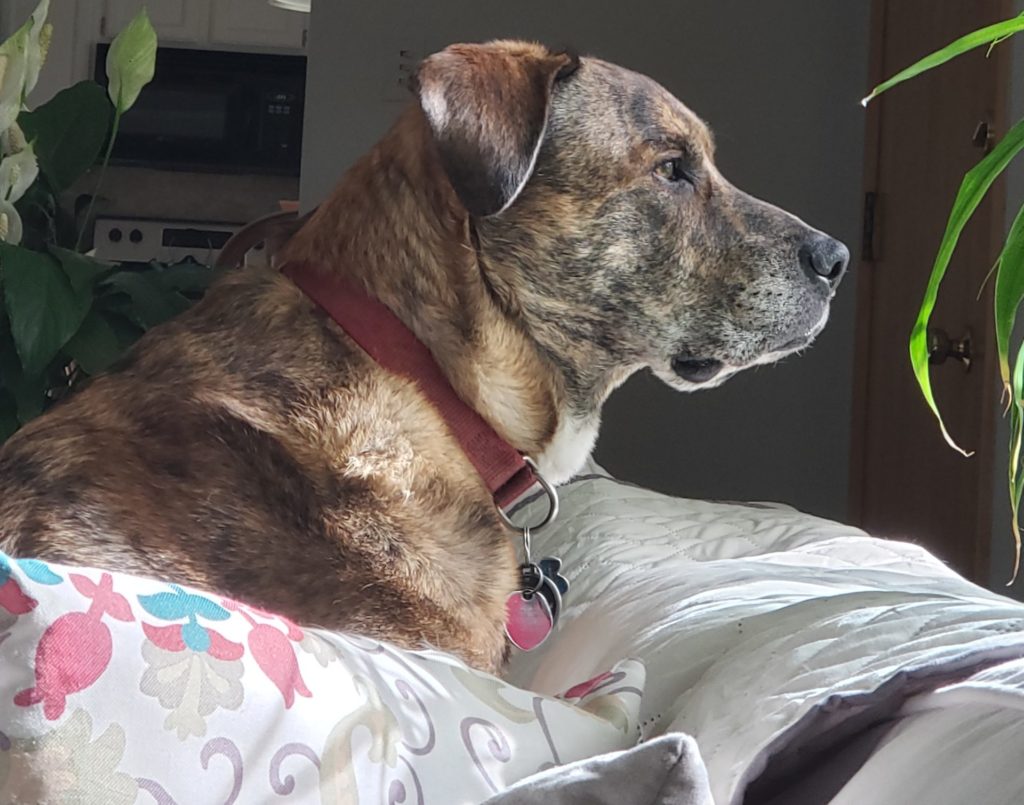If you’ve followed Pet Harmony for probably any length of time you’ve heard me talk about the four-legged love of my life, Oso:

But let me introduce you to my four-legged nemesis: Winter Oso.

I first met Winter Oso in the winter of 2018. I wish I could blame it on the polar vortex but he arrived prior to that. Winter Oso is squirrely. He cruises around in the evenings looking for mischief and driving us crazy. He destroys his bed. He decides to bark at the birds on the feeder for the first time ever. He gets into things he’s left alone for years. He’s such a nuisance that my husband and I actually, truly call him “Winter Oso” when he’s like that. And the worst part? Winter Oso is our fault.
Oso generally gets a lot of enrichment: playtime in the yard, training sessions, daily food puzzles, regular scent work, lots of toys, chews, and destructible items, and lots of snuggle time. He’s 7 years old and pretty happy to lounge on the couch with us in the evenings. This enrichment routine was enough to keep him calm and even keel for a year and a half after we adopted him.
It Was Enough Until It Wasn’t
When Winter Oso arrived, I went through the same thing that a lot of my clients go through:
But I do so much for my pet. Are you saying that it’s not enough?
I was in denial that Winter Oso was a product of me not meeting his needs. “I do all this stuff for him! It should be enough!” While I thought that I was doing enough, Winter Oso was clearly telling me through his behavior that his needs weren’t being met. If I were meeting his needs better, he would be acting like his normal self instead of this new, squirrely beast.
It took a couple weeks of being annoyed and angry with him (hello, prelearning dip) for me to accept that I had to change course. If this were a client, I would tell them to increase or explore different options for mental and physical exercise. I was letting ideology—what it should be– get in the way of observation—what it actually is.
Solving Winter Oso
Increasing mental and physical exercise is just what we did. We played “find it” with every dinner spanning two floors of the house and getting in a lot of time up and down the stairs. It took 45 minutes. Every. Night. But it worked. Winter Oso was held at bay as long as we did this exercise.
We’ve now reached the one-year anniversary of meeting our four-legged nemesis. But this year, we were prepared. Winter Oso arrived during that cold spell we had in October: early but recognizable nonetheless. He started being more active in the evenings. He started destroying his bed: something we only saw during winter of last year.
We knew what to do, but… we moved into a new house this spring and no longer have the option of the exact same exercise that I was doing before (no stairs). That meant that I had to figure out exactly what was different about his enrichment schedule now vs. in warmer months and what the previous dinner exercise was actually doing to meet his needs.
We tried “find it” in the yard with his entire dinner a few days in a row. It took a little of the edge off but he was still squirrely. That meant it wasn’t a mental exercise problem. Aha! It was specifically going up and down the stairs during that dinner exercise that improved his behavior. He needed more physical exercise. But, why then, did we not need to worry about his physical exercise needs in the warmer months but did in the winter even if he spent the same amount of time in the yard on a warmer winter day?
It took me a few days to figure it out, but I realized two components that were different about his summer and winter yard times. 1) He’s more active in general when we’re outside too and we’re outside with him quite a bit when it’s warm out but not when it’s cold. 2) The reason we can get away with yard time as his primary form of physical exercise (besides age) is the wildlife.
Oso is a hunter and a threat to all things cute and fuzzy. He chases the squirrels, digs for voles, and gives birds a run for their money. We don’t mind it as long as he’s not incessantly barking; he’s a dog after all and it’s all normal dog behavior. In short, he gets a ton of exercise by just being a dog hunting for critters. In the winter, there are far fewer critters for him to antagonize and that means we need to step up our game and be the ones to provide him with his physical exercise needs.
We now play together in the yard almost every day for at least 5-10 minutes. We’ve invented a yard game that has him running for a large part of that time and that often does the trick. If he still needs more exercise a hardcore tug session with him and the husband will take care of the rest of his energy. The best part of this new routine is that its far more sustainable than our previous exercise. Winter Oso is no more and I have the four-legged love of my life back.
Now what?
- Are there times where your pet is squirrely and you wished they’d just calm down? That is often a result of not meeting all their needs, like with Winter Oso. Take a step back and truly evaluate your pet’s behavior. Don’t let what you think it should be cloud your view of what it really is.
- If your pet is like Oso in that their behavior changes with the seasons, evaluate what is different. It might be something that’s not as easy to notice, like a change in critter density!
- If your pet has undesirable behaviors regularly, evaluate what the function of their behavior is. What do they get out of doing it? What needs are the undesirable behaviors meeting?
- Start experimenting with different activities. Play with duration, time of day, and type of activity. It’s not necessarily about adding “more”. Often, it’s just about “different”. For instance, instead of a 10-minute walk try a 10-minute flirt pole session if your pet needs more physical exercise. Check out our book Canine Enrichment for the Real World for ideas and information on meeting your pet’s needs.
- Keep track of what works and doesn’t work to address your pet’s behavior. That way the next time you see the change in behavior start you know exactly what to do and when!
- Do you recognize that you have a Winter Oso on your hands but want professional help with addressing it? Email us at [email protected] to sign up for a behavior consultation!
Happy training!
Allie
